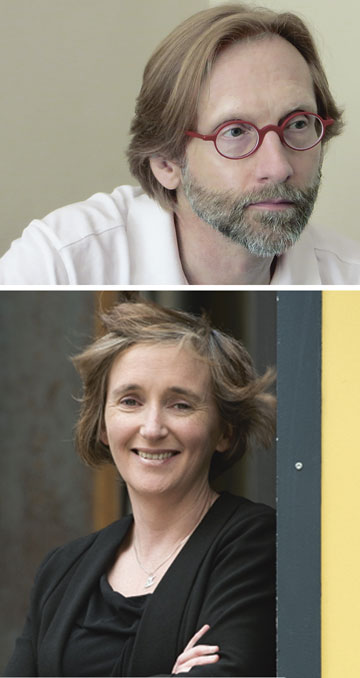USA, Literature, 2015
Lance
Olsen

“One is tempted to call him Lance Armstrong – if for nothing more than his turbo-charged prose, lightning fast intellect, and an ability to delay the truth.” That’s how the Berlin-based American Academy sums up Olsen’s work, who was the Mary Ellen von der Heyden Berlin Prize in Fiction Fellow from January to May 2013. One of America’s foremost metamodern writers, Olsen has a teaching position at the University of Utah for experimental narrative theory and practice.
To date, his oeuvre includes 12 novels, a hypermedia text, two “anti-textbooks,” and several short story collections as well a book of essays about innovative contemporary fiction. His work can be characterized by the way he continually transgresses traditional borders demarcating the various genres and blends lyric with prose, fact with fiction, and theory with narrative. The goal of the enterprise: to always question the borders of what we know, how we write, and what we write about. In the words of the anonymous narrator in Olsen’s 2002 novel Girl Imagined by Chance, “The unreal is exactly like the real, only more sincere.” The novel recounts the story of a childless couple that feigns a pregnancy in order to appease a relative. Over the course of the novel, the lies begin to add up; the fiction creates facts that are even accompanied by photographs sent by the couple – and that are in turn published in the novel. This aleatory authorial technique highlights the ambiguous nature of text and image: Olsen transforms this into more general reflections on the nature of representation and reproduction – the latter of which includes the medium of writing, according to Olsen. He reaps literary capital out of the distance between the real and the fictional, which in his eyes cannot be overcome. As he explained in an interview in 2002, language is all too often considered to be a kind of window we look out of to glimpse the truth. He is interested in liminal states, that is, the areas in which every fiction becomes part of our own memory – and every act of remembering encompasses fictional elements as well. It is this productive vein that he mines for his fictional biographies, which are based on intensive research and tell a story that the facts cannot. In the 2006 book Nietzsche’s Kisses, for example, he slips into the consciousness of the dying philosopher and shows how lost he is in his confused state. The plot’s complex construction oscillates between three narrative points-of-view: impressions of the sanitarium, as told by the first-person narrator; dream sequences recounted in the second-person form; and, finally, historical vignettes in the third person, all of which come together to create a cycle composed of fragments, thereby re-enacting the very estrangement from the self that is the subject of Nietzsche’s philosophy. Published in 2007, Olsen brings another icon of literary modernism to life in Anxious Pleasures: here he re-imagines Franz Kafka’s hero Gregor Samsa from the perspective of minor characters, such as Gregor’s neighbor. With its multiple perspectives, his novel Calendar of Regrets (2010) is a wild phantasm that travels through time and space and takes the poisoning of the Dutch painter Hieronymus Bosch as the narrative’s starting point: each of the twelve chapters, and each of the twelve narrative threads, has its own tone and typography. In the novel, we encounter a stranded angel, a mysterious man with borrowed organs, and a Burmese-based photographer. The book is about memory, travel, originality, and the etiology of stories that repeat ad infinitum for the reason that everything has the potential to become a story: “Look closely,” reads a line from the opening scene, “everything is webbed with everything, existence an illuminated manuscript you walk through.” Critics point out that the author is merely playing with randomness: obsessed by the superficial, he ignores specific historic and cultural details. And yet through the process of writing, Olsen counteracts things like the amnesia plaguing our society, the predetermined modes of thought that narrow our worldview as a multifaceted text, and death, which eventually undermines everything. This can be seen in both of the books he wrote during his residency at the American Academy in Berlin: a so-called “trash diary” about his stay in Berlin, There (2014) is composed like a collage which, like a time machine, brings together characters like Samuel Beckett with Ben Marcus, and David Bowie with Bhutan. His most recent novel Theories of Forgetting (2014) is based on “Spiral Jetty,” the most famous work of the earthworks artist Robert Smithson. The novel weaves together three levels of plot with three temporal levels: the plots include the filmmaker Amelia’s attempts to finish a documentary about Smithson; the story of her husband Hugh and his gradual disappearance after Amelia’s death; and the footnotes that Amelia’s daughter – a Berlin-based art critic – adds to the manuscript she found in her father’s estate after his death. Every page is divided into two topographic halves, on which the various narrative threads unfold in opposite directions, creating a spiral. Again and again, Olsen’s work show his attention to form: in his estimation, form is the vessel through which the novelist can harness the potential of innovative contemporary fiction; or, as Olsen puts it, the potential to continually describe the present moment afresh: “One of the jobs of the innovative is unceasingly to challenge the dominant cultures’ narrativization of ‘reality,’ to remind us that there are always other ways to construct the text of our texts, the texts of our lives. … To write within the innovative, then, is much more than a creative choice. It’s an ethical imperative.” (Interview with Lance Olsen in: HTMLGiant, 9.4.2012.)
Text: Claudia Kramatschek
Translation: Amy Pradell
Camera/editing: Uli Aumüller, Sebastian Rausch


